Role of Contingent Leadership & Management on Employee Performance
VerifiedAdded on 2020/01/28
|39
|11396
|426
Thesis and Dissertation
AI Summary
This dissertation examines the impact of contingent leadership and management styles on employee performance, focusing on the Virgin Group as a case study. The study explores the background of the research, its rationale, aims, objectives, and research questions. It investigates the significance of leadership and management in the business unit, critically evaluates theoretical perspectives of contingent leadership and management styles, and assesses their impact on employee performance. The research also aims to recommend ways of enhancing employee performance within the organization. The literature review covers leadership and management concepts, their significance, and various leadership styles. The dissertation is structured with an introduction, literature review, research methodology, research analysis and discussion, and a conclusion with recommendations. The study utilizes secondary information from books, journals, and online articles to develop a comprehensive understanding of the subject matter. The research aims to provide insights into how different leadership styles affect employee performance, contributing to the existing body of knowledge and offering practical implications for businesses.
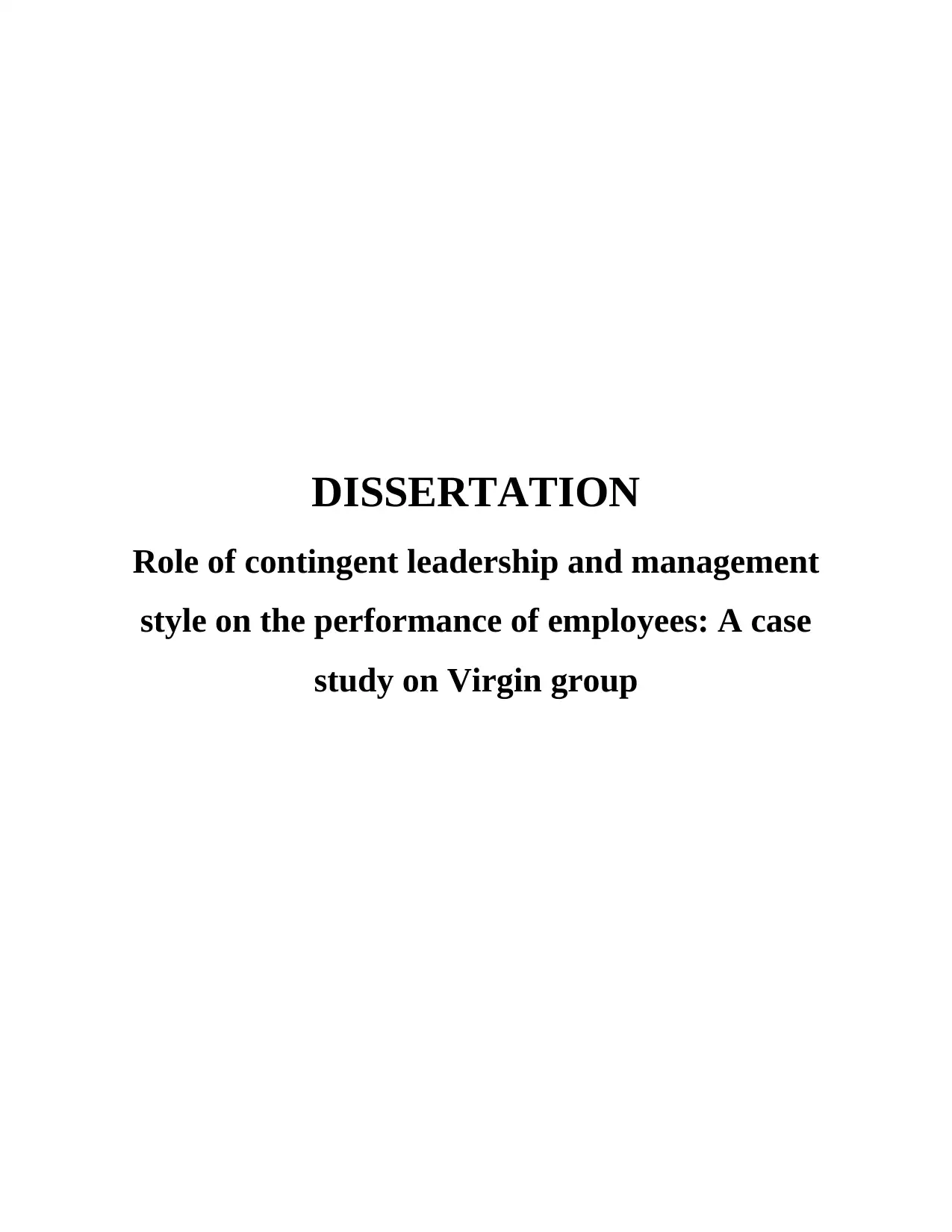
DISSERTATION
Role of contingent leadership and management
style on the performance of employees: A case
study on Virgin group
Role of contingent leadership and management
style on the performance of employees: A case
study on Virgin group
Paraphrase This Document
Need a fresh take? Get an instant paraphrase of this document with our AI Paraphraser
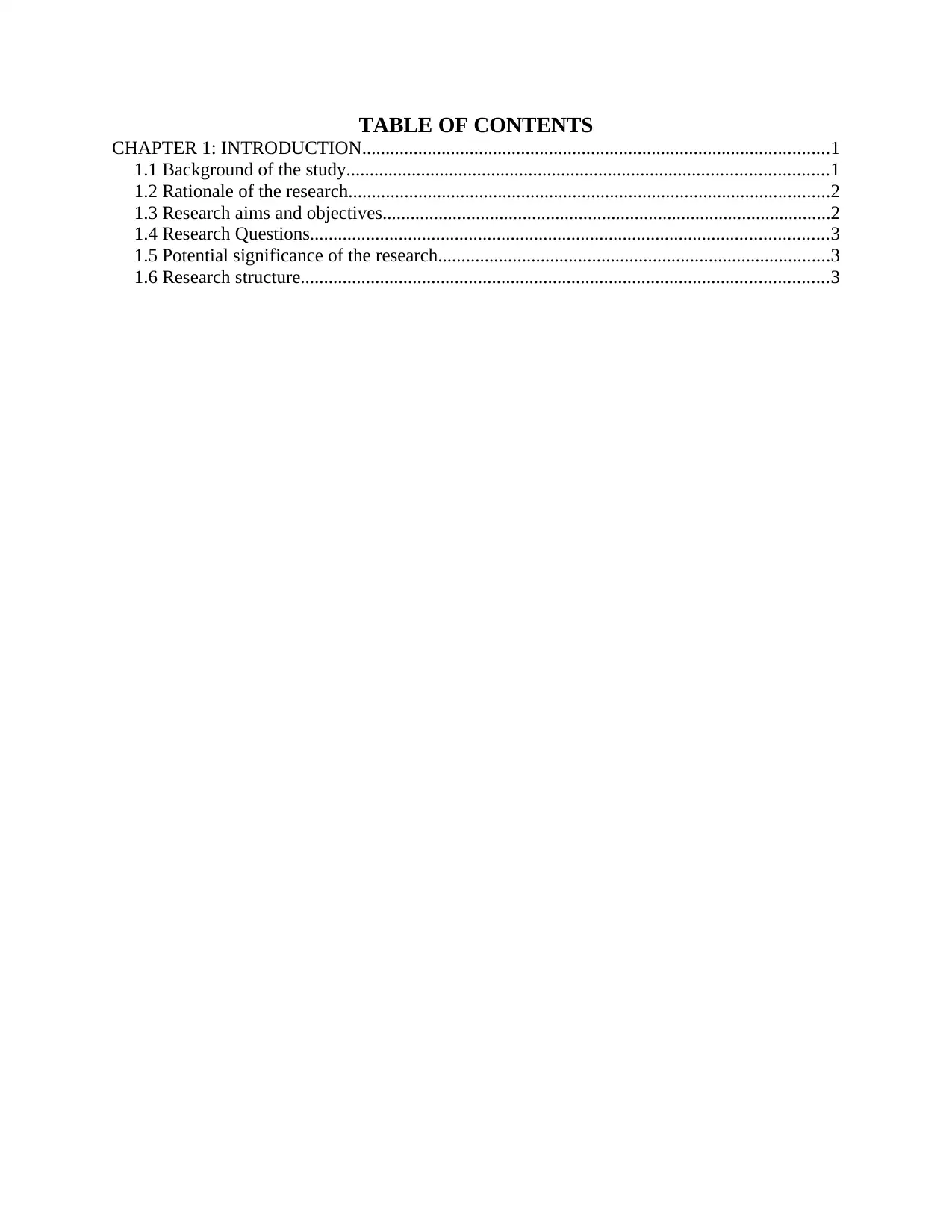
TABLE OF CONTENTS
CHAPTER 1: INTRODUCTION....................................................................................................1
1.1 Background of the study.......................................................................................................1
1.2 Rationale of the research.......................................................................................................2
1.3 Research aims and objectives................................................................................................2
1.4 Research Questions...............................................................................................................3
1.5 Potential significance of the research....................................................................................3
1.6 Research structure.................................................................................................................3
CHAPTER 1: INTRODUCTION....................................................................................................1
1.1 Background of the study.......................................................................................................1
1.2 Rationale of the research.......................................................................................................2
1.3 Research aims and objectives................................................................................................2
1.4 Research Questions...............................................................................................................3
1.5 Potential significance of the research....................................................................................3
1.6 Research structure.................................................................................................................3
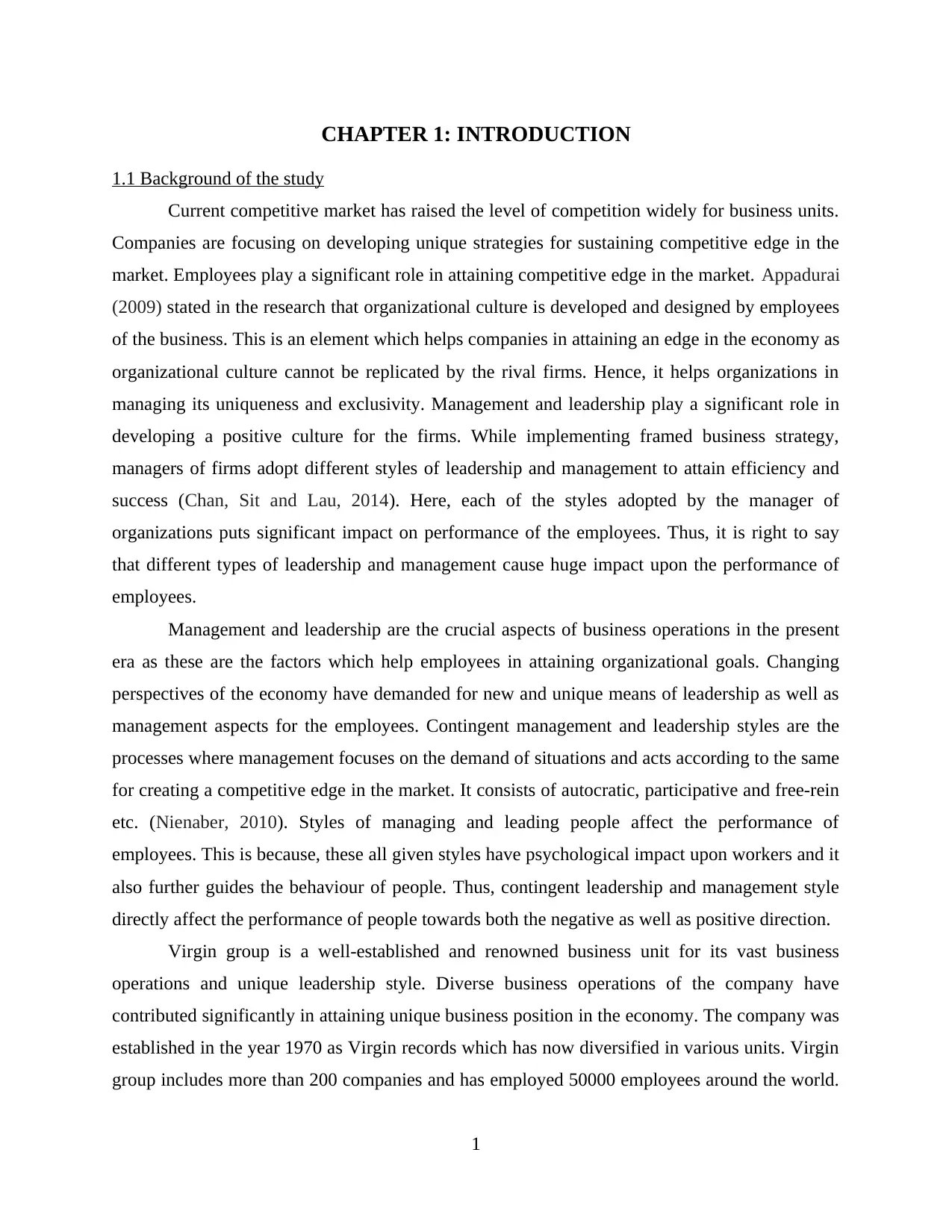
CHAPTER 1: INTRODUCTION
1.1 Background of the study
Current competitive market has raised the level of competition widely for business units.
Companies are focusing on developing unique strategies for sustaining competitive edge in the
market. Employees play a significant role in attaining competitive edge in the market. Appadurai
(2009) stated in the research that organizational culture is developed and designed by employees
of the business. This is an element which helps companies in attaining an edge in the economy as
organizational culture cannot be replicated by the rival firms. Hence, it helps organizations in
managing its uniqueness and exclusivity. Management and leadership play a significant role in
developing a positive culture for the firms. While implementing framed business strategy,
managers of firms adopt different styles of leadership and management to attain efficiency and
success (Chan, Sit and Lau, 2014). Here, each of the styles adopted by the manager of
organizations puts significant impact on performance of the employees. Thus, it is right to say
that different types of leadership and management cause huge impact upon the performance of
employees.
Management and leadership are the crucial aspects of business operations in the present
era as these are the factors which help employees in attaining organizational goals. Changing
perspectives of the economy have demanded for new and unique means of leadership as well as
management aspects for the employees. Contingent management and leadership styles are the
processes where management focuses on the demand of situations and acts according to the same
for creating a competitive edge in the market. It consists of autocratic, participative and free-rein
etc. (Nienaber, 2010). Styles of managing and leading people affect the performance of
employees. This is because, these all given styles have psychological impact upon workers and it
also further guides the behaviour of people. Thus, contingent leadership and management style
directly affect the performance of people towards both the negative as well as positive direction.
Virgin group is a well-established and renowned business unit for its vast business
operations and unique leadership style. Diverse business operations of the company have
contributed significantly in attaining unique business position in the economy. The company was
established in the year 1970 as Virgin records which has now diversified in various units. Virgin
group includes more than 200 companies and has employed 50000 employees around the world.
1
1.1 Background of the study
Current competitive market has raised the level of competition widely for business units.
Companies are focusing on developing unique strategies for sustaining competitive edge in the
market. Employees play a significant role in attaining competitive edge in the market. Appadurai
(2009) stated in the research that organizational culture is developed and designed by employees
of the business. This is an element which helps companies in attaining an edge in the economy as
organizational culture cannot be replicated by the rival firms. Hence, it helps organizations in
managing its uniqueness and exclusivity. Management and leadership play a significant role in
developing a positive culture for the firms. While implementing framed business strategy,
managers of firms adopt different styles of leadership and management to attain efficiency and
success (Chan, Sit and Lau, 2014). Here, each of the styles adopted by the manager of
organizations puts significant impact on performance of the employees. Thus, it is right to say
that different types of leadership and management cause huge impact upon the performance of
employees.
Management and leadership are the crucial aspects of business operations in the present
era as these are the factors which help employees in attaining organizational goals. Changing
perspectives of the economy have demanded for new and unique means of leadership as well as
management aspects for the employees. Contingent management and leadership styles are the
processes where management focuses on the demand of situations and acts according to the same
for creating a competitive edge in the market. It consists of autocratic, participative and free-rein
etc. (Nienaber, 2010). Styles of managing and leading people affect the performance of
employees. This is because, these all given styles have psychological impact upon workers and it
also further guides the behaviour of people. Thus, contingent leadership and management style
directly affect the performance of people towards both the negative as well as positive direction.
Virgin group is a well-established and renowned business unit for its vast business
operations and unique leadership style. Diverse business operations of the company have
contributed significantly in attaining unique business position in the economy. The company was
established in the year 1970 as Virgin records which has now diversified in various units. Virgin
group includes more than 200 companies and has employed 50000 employees around the world.
1
⊘ This is a preview!⊘
Do you want full access?
Subscribe today to unlock all pages.

Trusted by 1+ million students worldwide
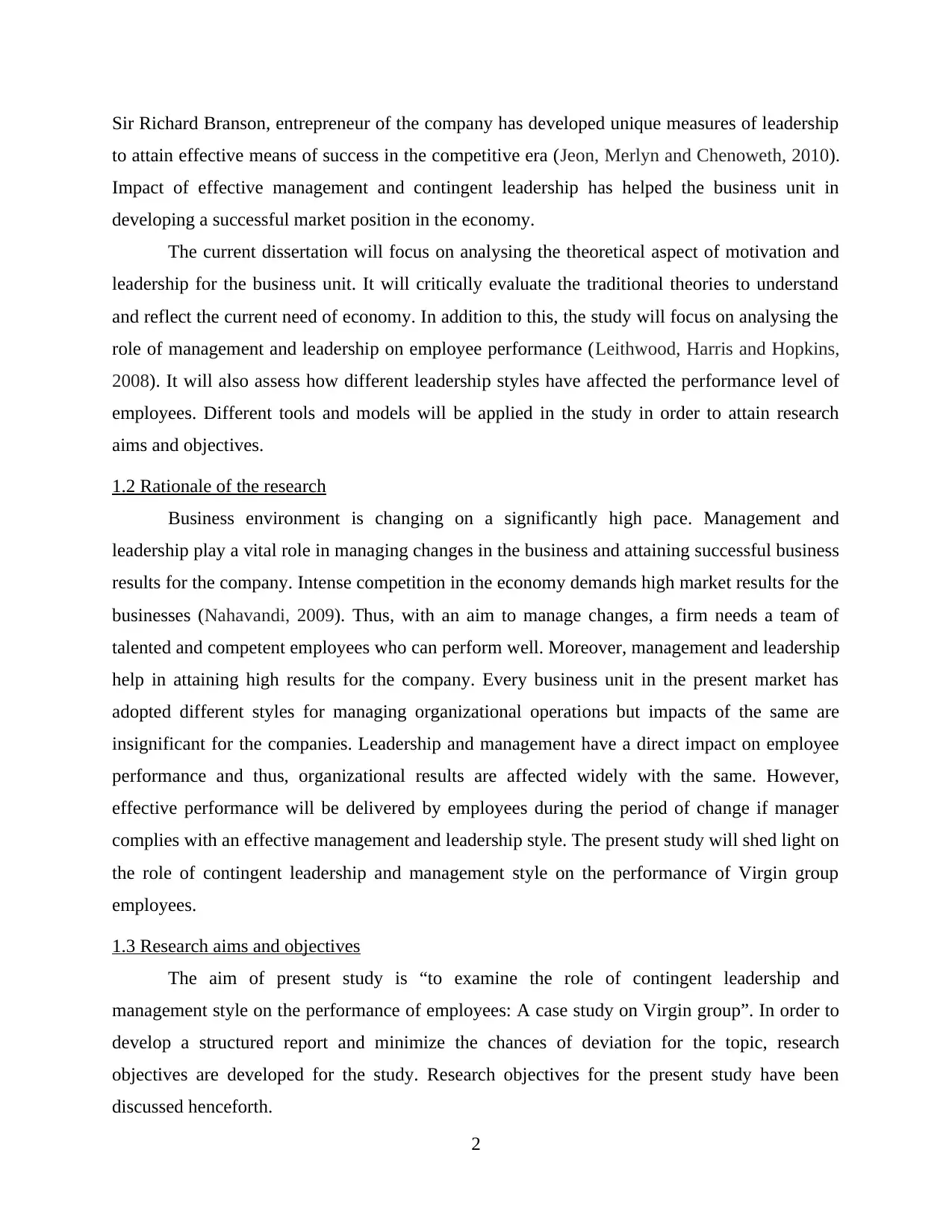
Sir Richard Branson, entrepreneur of the company has developed unique measures of leadership
to attain effective means of success in the competitive era (Jeon, Merlyn and Chenoweth, 2010).
Impact of effective management and contingent leadership has helped the business unit in
developing a successful market position in the economy.
The current dissertation will focus on analysing the theoretical aspect of motivation and
leadership for the business unit. It will critically evaluate the traditional theories to understand
and reflect the current need of economy. In addition to this, the study will focus on analysing the
role of management and leadership on employee performance (Leithwood, Harris and Hopkins,
2008). It will also assess how different leadership styles have affected the performance level of
employees. Different tools and models will be applied in the study in order to attain research
aims and objectives.
1.2 Rationale of the research
Business environment is changing on a significantly high pace. Management and
leadership play a vital role in managing changes in the business and attaining successful business
results for the company. Intense competition in the economy demands high market results for the
businesses (Nahavandi, 2009). Thus, with an aim to manage changes, a firm needs a team of
talented and competent employees who can perform well. Moreover, management and leadership
help in attaining high results for the company. Every business unit in the present market has
adopted different styles for managing organizational operations but impacts of the same are
insignificant for the companies. Leadership and management have a direct impact on employee
performance and thus, organizational results are affected widely with the same. However,
effective performance will be delivered by employees during the period of change if manager
complies with an effective management and leadership style. The present study will shed light on
the role of contingent leadership and management style on the performance of Virgin group
employees.
1.3 Research aims and objectives
The aim of present study is “to examine the role of contingent leadership and
management style on the performance of employees: A case study on Virgin group”. In order to
develop a structured report and minimize the chances of deviation for the topic, research
objectives are developed for the study. Research objectives for the present study have been
discussed henceforth.
2
to attain effective means of success in the competitive era (Jeon, Merlyn and Chenoweth, 2010).
Impact of effective management and contingent leadership has helped the business unit in
developing a successful market position in the economy.
The current dissertation will focus on analysing the theoretical aspect of motivation and
leadership for the business unit. It will critically evaluate the traditional theories to understand
and reflect the current need of economy. In addition to this, the study will focus on analysing the
role of management and leadership on employee performance (Leithwood, Harris and Hopkins,
2008). It will also assess how different leadership styles have affected the performance level of
employees. Different tools and models will be applied in the study in order to attain research
aims and objectives.
1.2 Rationale of the research
Business environment is changing on a significantly high pace. Management and
leadership play a vital role in managing changes in the business and attaining successful business
results for the company. Intense competition in the economy demands high market results for the
businesses (Nahavandi, 2009). Thus, with an aim to manage changes, a firm needs a team of
talented and competent employees who can perform well. Moreover, management and leadership
help in attaining high results for the company. Every business unit in the present market has
adopted different styles for managing organizational operations but impacts of the same are
insignificant for the companies. Leadership and management have a direct impact on employee
performance and thus, organizational results are affected widely with the same. However,
effective performance will be delivered by employees during the period of change if manager
complies with an effective management and leadership style. The present study will shed light on
the role of contingent leadership and management style on the performance of Virgin group
employees.
1.3 Research aims and objectives
The aim of present study is “to examine the role of contingent leadership and
management style on the performance of employees: A case study on Virgin group”. In order to
develop a structured report and minimize the chances of deviation for the topic, research
objectives are developed for the study. Research objectives for the present study have been
discussed henceforth.
2
Paraphrase This Document
Need a fresh take? Get an instant paraphrase of this document with our AI Paraphraser
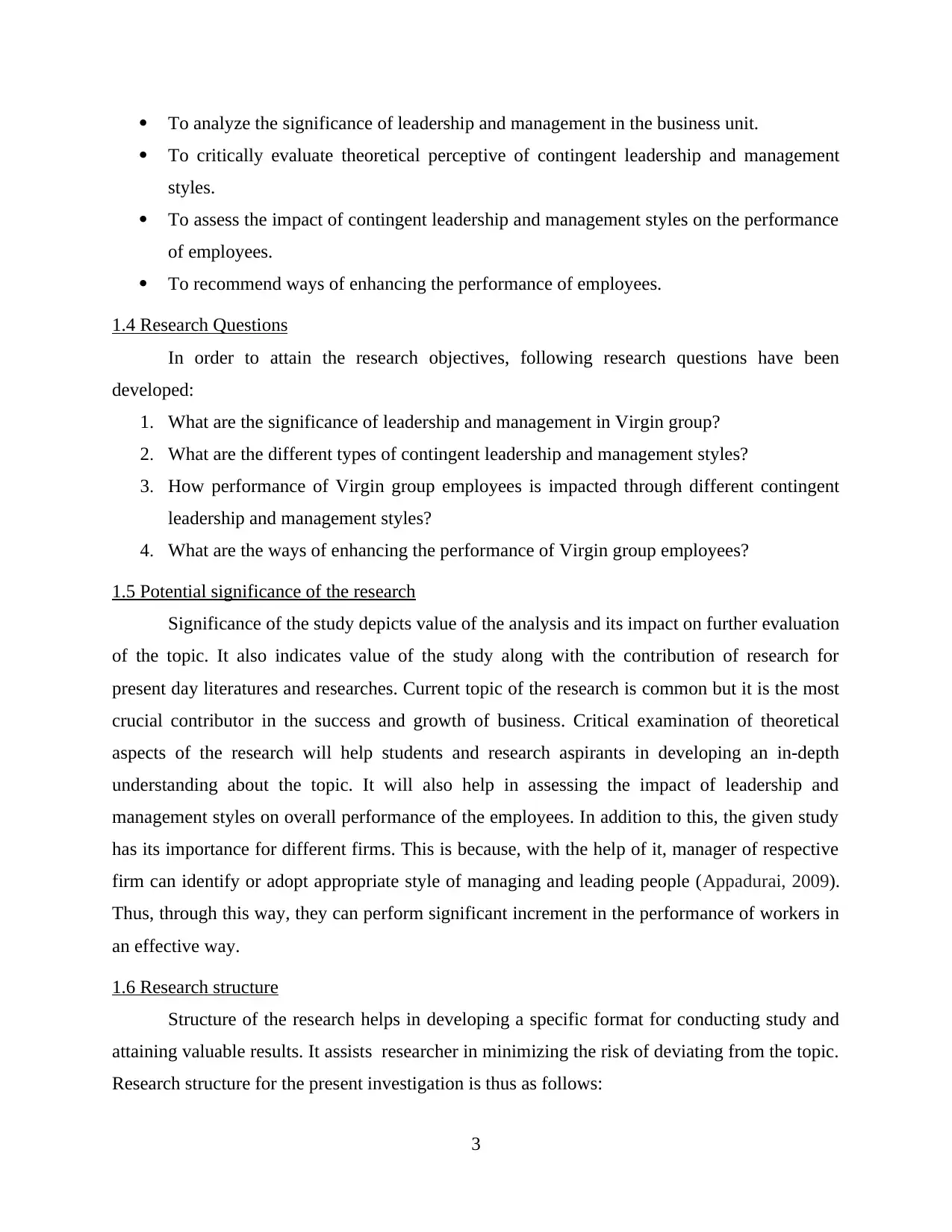
To analyze the significance of leadership and management in the business unit.
To critically evaluate theoretical perceptive of contingent leadership and management
styles.
To assess the impact of contingent leadership and management styles on the performance
of employees.
To recommend ways of enhancing the performance of employees.
1.4 Research Questions
In order to attain the research objectives, following research questions have been
developed:
1. What are the significance of leadership and management in Virgin group?
2. What are the different types of contingent leadership and management styles?
3. How performance of Virgin group employees is impacted through different contingent
leadership and management styles?
4. What are the ways of enhancing the performance of Virgin group employees?
1.5 Potential significance of the research
Significance of the study depicts value of the analysis and its impact on further evaluation
of the topic. It also indicates value of the study along with the contribution of research for
present day literatures and researches. Current topic of the research is common but it is the most
crucial contributor in the success and growth of business. Critical examination of theoretical
aspects of the research will help students and research aspirants in developing an in-depth
understanding about the topic. It will also help in assessing the impact of leadership and
management styles on overall performance of the employees. In addition to this, the given study
has its importance for different firms. This is because, with the help of it, manager of respective
firm can identify or adopt appropriate style of managing and leading people (Appadurai, 2009).
Thus, through this way, they can perform significant increment in the performance of workers in
an effective way.
1.6 Research structure
Structure of the research helps in developing a specific format for conducting study and
attaining valuable results. It assists researcher in minimizing the risk of deviating from the topic.
Research structure for the present investigation is thus as follows:
3
To critically evaluate theoretical perceptive of contingent leadership and management
styles.
To assess the impact of contingent leadership and management styles on the performance
of employees.
To recommend ways of enhancing the performance of employees.
1.4 Research Questions
In order to attain the research objectives, following research questions have been
developed:
1. What are the significance of leadership and management in Virgin group?
2. What are the different types of contingent leadership and management styles?
3. How performance of Virgin group employees is impacted through different contingent
leadership and management styles?
4. What are the ways of enhancing the performance of Virgin group employees?
1.5 Potential significance of the research
Significance of the study depicts value of the analysis and its impact on further evaluation
of the topic. It also indicates value of the study along with the contribution of research for
present day literatures and researches. Current topic of the research is common but it is the most
crucial contributor in the success and growth of business. Critical examination of theoretical
aspects of the research will help students and research aspirants in developing an in-depth
understanding about the topic. It will also help in assessing the impact of leadership and
management styles on overall performance of the employees. In addition to this, the given study
has its importance for different firms. This is because, with the help of it, manager of respective
firm can identify or adopt appropriate style of managing and leading people (Appadurai, 2009).
Thus, through this way, they can perform significant increment in the performance of workers in
an effective way.
1.6 Research structure
Structure of the research helps in developing a specific format for conducting study and
attaining valuable results. It assists researcher in minimizing the risk of deviating from the topic.
Research structure for the present investigation is thus as follows:
3
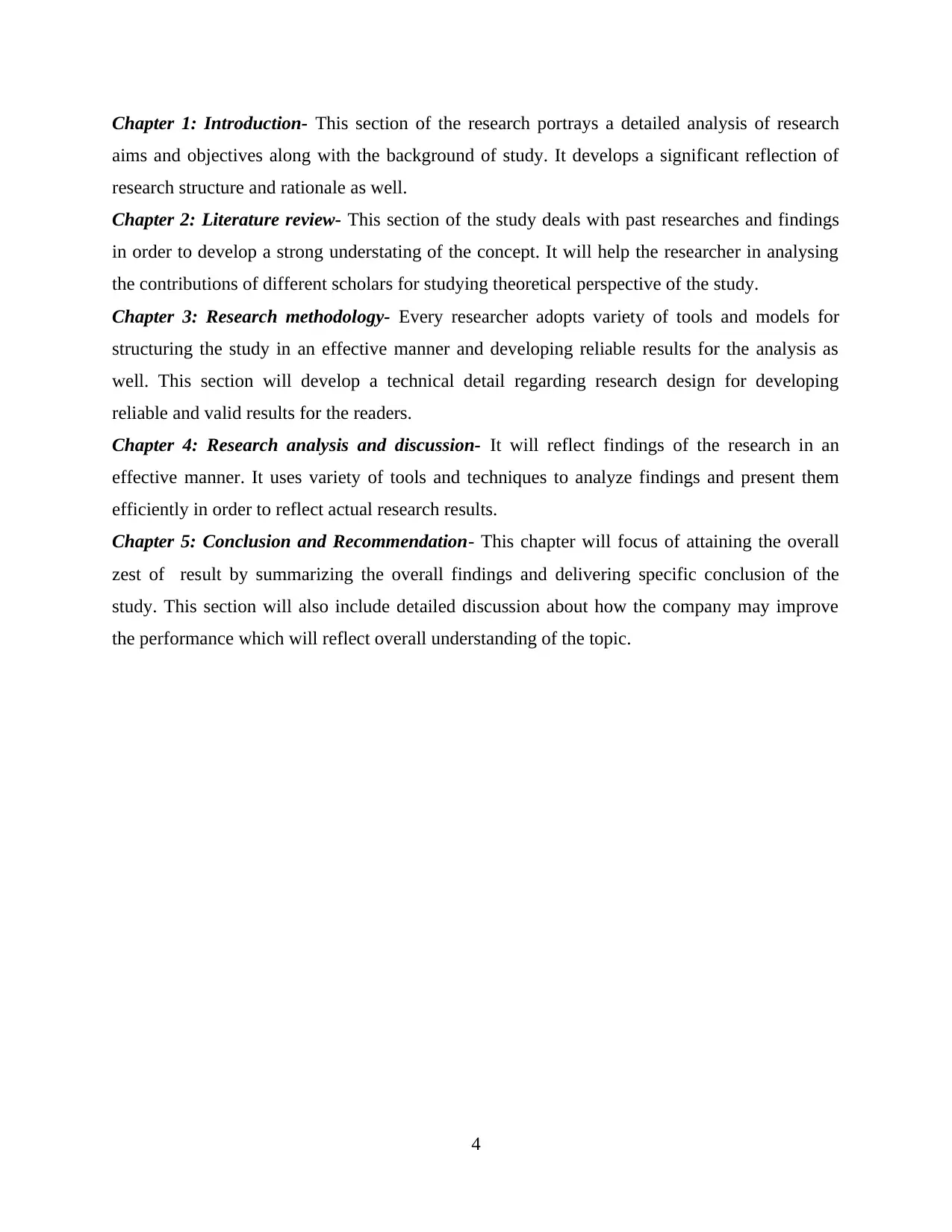
Chapter 1: Introduction- This section of the research portrays a detailed analysis of research
aims and objectives along with the background of study. It develops a significant reflection of
research structure and rationale as well.
Chapter 2: Literature review- This section of the study deals with past researches and findings
in order to develop a strong understating of the concept. It will help the researcher in analysing
the contributions of different scholars for studying theoretical perspective of the study.
Chapter 3: Research methodology- Every researcher adopts variety of tools and models for
structuring the study in an effective manner and developing reliable results for the analysis as
well. This section will develop a technical detail regarding research design for developing
reliable and valid results for the readers.
Chapter 4: Research analysis and discussion- It will reflect findings of the research in an
effective manner. It uses variety of tools and techniques to analyze findings and present them
efficiently in order to reflect actual research results.
Chapter 5: Conclusion and Recommendation- This chapter will focus of attaining the overall
zest of result by summarizing the overall findings and delivering specific conclusion of the
study. This section will also include detailed discussion about how the company may improve
the performance which will reflect overall understanding of the topic.
4
aims and objectives along with the background of study. It develops a significant reflection of
research structure and rationale as well.
Chapter 2: Literature review- This section of the study deals with past researches and findings
in order to develop a strong understating of the concept. It will help the researcher in analysing
the contributions of different scholars for studying theoretical perspective of the study.
Chapter 3: Research methodology- Every researcher adopts variety of tools and models for
structuring the study in an effective manner and developing reliable results for the analysis as
well. This section will develop a technical detail regarding research design for developing
reliable and valid results for the readers.
Chapter 4: Research analysis and discussion- It will reflect findings of the research in an
effective manner. It uses variety of tools and techniques to analyze findings and present them
efficiently in order to reflect actual research results.
Chapter 5: Conclusion and Recommendation- This chapter will focus of attaining the overall
zest of result by summarizing the overall findings and delivering specific conclusion of the
study. This section will also include detailed discussion about how the company may improve
the performance which will reflect overall understanding of the topic.
4
⊘ This is a preview!⊘
Do you want full access?
Subscribe today to unlock all pages.

Trusted by 1+ million students worldwide
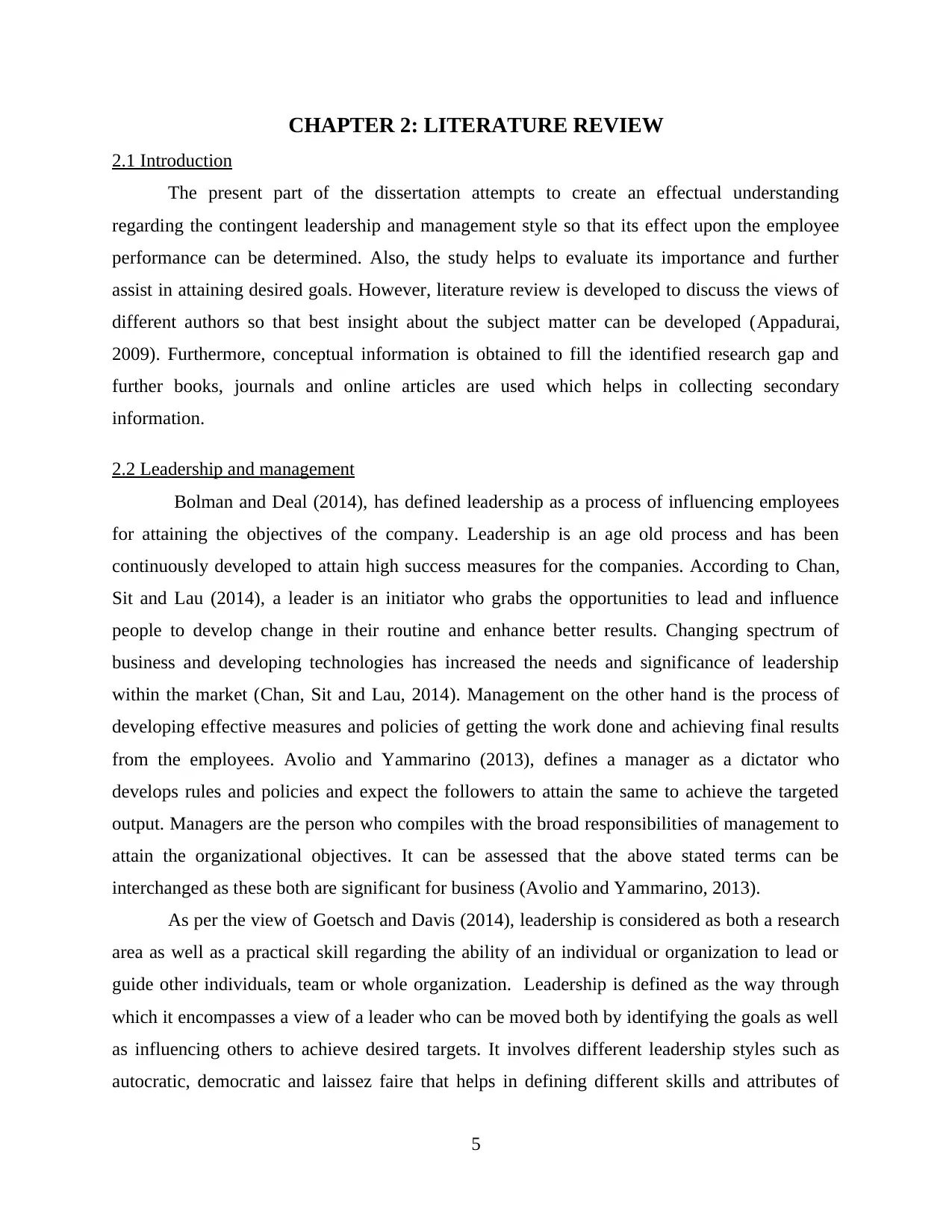
CHAPTER 2: LITERATURE REVIEW
2.1 Introduction
The present part of the dissertation attempts to create an effectual understanding
regarding the contingent leadership and management style so that its effect upon the employee
performance can be determined. Also, the study helps to evaluate its importance and further
assist in attaining desired goals. However, literature review is developed to discuss the views of
different authors so that best insight about the subject matter can be developed (Appadurai,
2009). Furthermore, conceptual information is obtained to fill the identified research gap and
further books, journals and online articles are used which helps in collecting secondary
information.
2.2 Leadership and management
Bolman and Deal (2014), has defined leadership as a process of influencing employees
for attaining the objectives of the company. Leadership is an age old process and has been
continuously developed to attain high success measures for the companies. According to Chan,
Sit and Lau (2014), a leader is an initiator who grabs the opportunities to lead and influence
people to develop change in their routine and enhance better results. Changing spectrum of
business and developing technologies has increased the needs and significance of leadership
within the market (Chan, Sit and Lau, 2014). Management on the other hand is the process of
developing effective measures and policies of getting the work done and achieving final results
from the employees. Avolio and Yammarino (2013), defines a manager as a dictator who
develops rules and policies and expect the followers to attain the same to achieve the targeted
output. Managers are the person who compiles with the broad responsibilities of management to
attain the organizational objectives. It can be assessed that the above stated terms can be
interchanged as these both are significant for business (Avolio and Yammarino, 2013).
As per the view of Goetsch and Davis (2014), leadership is considered as both a research
area as well as a practical skill regarding the ability of an individual or organization to lead or
guide other individuals, team or whole organization. Leadership is defined as the way through
which it encompasses a view of a leader who can be moved both by identifying the goals as well
as influencing others to achieve desired targets. It involves different leadership styles such as
autocratic, democratic and laissez faire that helps in defining different skills and attributes of
5
2.1 Introduction
The present part of the dissertation attempts to create an effectual understanding
regarding the contingent leadership and management style so that its effect upon the employee
performance can be determined. Also, the study helps to evaluate its importance and further
assist in attaining desired goals. However, literature review is developed to discuss the views of
different authors so that best insight about the subject matter can be developed (Appadurai,
2009). Furthermore, conceptual information is obtained to fill the identified research gap and
further books, journals and online articles are used which helps in collecting secondary
information.
2.2 Leadership and management
Bolman and Deal (2014), has defined leadership as a process of influencing employees
for attaining the objectives of the company. Leadership is an age old process and has been
continuously developed to attain high success measures for the companies. According to Chan,
Sit and Lau (2014), a leader is an initiator who grabs the opportunities to lead and influence
people to develop change in their routine and enhance better results. Changing spectrum of
business and developing technologies has increased the needs and significance of leadership
within the market (Chan, Sit and Lau, 2014). Management on the other hand is the process of
developing effective measures and policies of getting the work done and achieving final results
from the employees. Avolio and Yammarino (2013), defines a manager as a dictator who
develops rules and policies and expect the followers to attain the same to achieve the targeted
output. Managers are the person who compiles with the broad responsibilities of management to
attain the organizational objectives. It can be assessed that the above stated terms can be
interchanged as these both are significant for business (Avolio and Yammarino, 2013).
As per the view of Goetsch and Davis (2014), leadership is considered as both a research
area as well as a practical skill regarding the ability of an individual or organization to lead or
guide other individuals, team or whole organization. Leadership is defined as the way through
which it encompasses a view of a leader who can be moved both by identifying the goals as well
as influencing others to achieve desired targets. It involves different leadership styles such as
autocratic, democratic and laissez faire that helps in defining different skills and attributes of
5
Paraphrase This Document
Need a fresh take? Get an instant paraphrase of this document with our AI Paraphraser
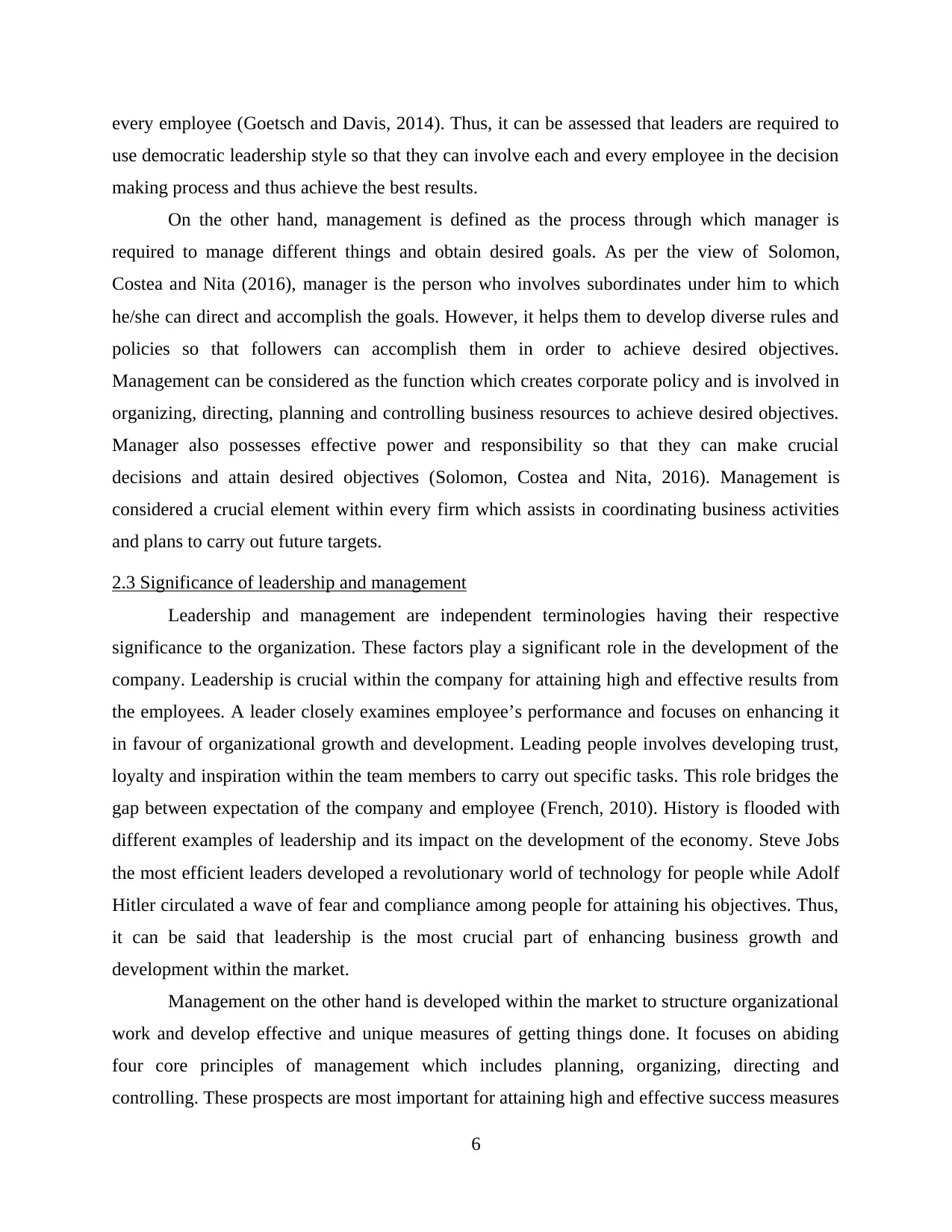
every employee (Goetsch and Davis, 2014). Thus, it can be assessed that leaders are required to
use democratic leadership style so that they can involve each and every employee in the decision
making process and thus achieve the best results.
On the other hand, management is defined as the process through which manager is
required to manage different things and obtain desired goals. As per the view of Solomon,
Costea and Nita (2016), manager is the person who involves subordinates under him to which
he/she can direct and accomplish the goals. However, it helps them to develop diverse rules and
policies so that followers can accomplish them in order to achieve desired objectives.
Management can be considered as the function which creates corporate policy and is involved in
organizing, directing, planning and controlling business resources to achieve desired objectives.
Manager also possesses effective power and responsibility so that they can make crucial
decisions and attain desired objectives (Solomon, Costea and Nita, 2016). Management is
considered a crucial element within every firm which assists in coordinating business activities
and plans to carry out future targets.
2.3 Significance of leadership and management
Leadership and management are independent terminologies having their respective
significance to the organization. These factors play a significant role in the development of the
company. Leadership is crucial within the company for attaining high and effective results from
the employees. A leader closely examines employee’s performance and focuses on enhancing it
in favour of organizational growth and development. Leading people involves developing trust,
loyalty and inspiration within the team members to carry out specific tasks. This role bridges the
gap between expectation of the company and employee (French, 2010). History is flooded with
different examples of leadership and its impact on the development of the economy. Steve Jobs
the most efficient leaders developed a revolutionary world of technology for people while Adolf
Hitler circulated a wave of fear and compliance among people for attaining his objectives. Thus,
it can be said that leadership is the most crucial part of enhancing business growth and
development within the market.
Management on the other hand is developed within the market to structure organizational
work and develop effective and unique measures of getting things done. It focuses on abiding
four core principles of management which includes planning, organizing, directing and
controlling. These prospects are most important for attaining high and effective success measures
6
use democratic leadership style so that they can involve each and every employee in the decision
making process and thus achieve the best results.
On the other hand, management is defined as the process through which manager is
required to manage different things and obtain desired goals. As per the view of Solomon,
Costea and Nita (2016), manager is the person who involves subordinates under him to which
he/she can direct and accomplish the goals. However, it helps them to develop diverse rules and
policies so that followers can accomplish them in order to achieve desired objectives.
Management can be considered as the function which creates corporate policy and is involved in
organizing, directing, planning and controlling business resources to achieve desired objectives.
Manager also possesses effective power and responsibility so that they can make crucial
decisions and attain desired objectives (Solomon, Costea and Nita, 2016). Management is
considered a crucial element within every firm which assists in coordinating business activities
and plans to carry out future targets.
2.3 Significance of leadership and management
Leadership and management are independent terminologies having their respective
significance to the organization. These factors play a significant role in the development of the
company. Leadership is crucial within the company for attaining high and effective results from
the employees. A leader closely examines employee’s performance and focuses on enhancing it
in favour of organizational growth and development. Leading people involves developing trust,
loyalty and inspiration within the team members to carry out specific tasks. This role bridges the
gap between expectation of the company and employee (French, 2010). History is flooded with
different examples of leadership and its impact on the development of the economy. Steve Jobs
the most efficient leaders developed a revolutionary world of technology for people while Adolf
Hitler circulated a wave of fear and compliance among people for attaining his objectives. Thus,
it can be said that leadership is the most crucial part of enhancing business growth and
development within the market.
Management on the other hand is developed within the market to structure organizational
work and develop effective and unique measures of getting things done. It focuses on abiding
four core principles of management which includes planning, organizing, directing and
controlling. These prospects are most important for attaining high and effective success measures
6
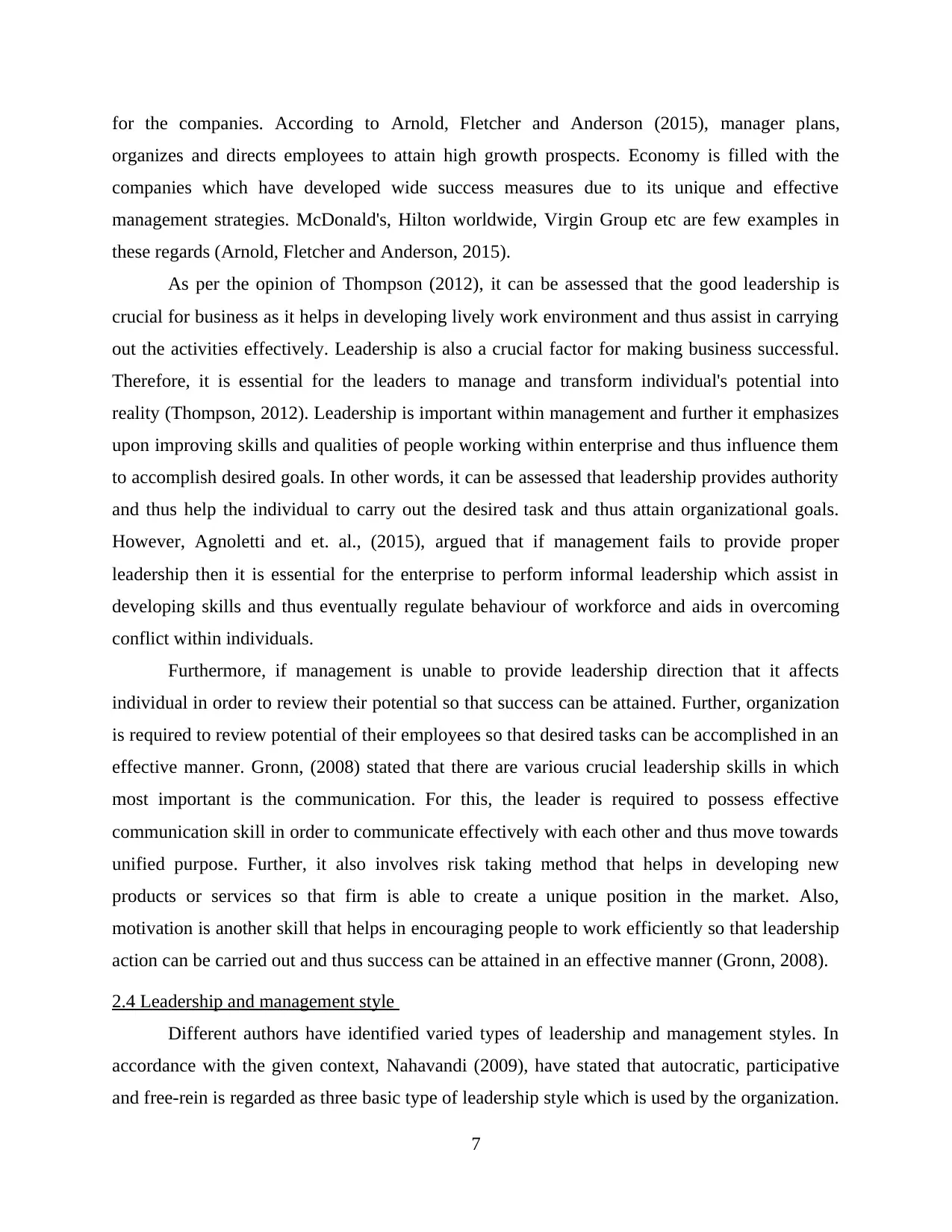
for the companies. According to Arnold, Fletcher and Anderson (2015), manager plans,
organizes and directs employees to attain high growth prospects. Economy is filled with the
companies which have developed wide success measures due to its unique and effective
management strategies. McDonald's, Hilton worldwide, Virgin Group etc are few examples in
these regards (Arnold, Fletcher and Anderson, 2015).
As per the opinion of Thompson (2012), it can be assessed that the good leadership is
crucial for business as it helps in developing lively work environment and thus assist in carrying
out the activities effectively. Leadership is also a crucial factor for making business successful.
Therefore, it is essential for the leaders to manage and transform individual's potential into
reality (Thompson, 2012). Leadership is important within management and further it emphasizes
upon improving skills and qualities of people working within enterprise and thus influence them
to accomplish desired goals. In other words, it can be assessed that leadership provides authority
and thus help the individual to carry out the desired task and thus attain organizational goals.
However, Agnoletti and et. al., (2015), argued that if management fails to provide proper
leadership then it is essential for the enterprise to perform informal leadership which assist in
developing skills and thus eventually regulate behaviour of workforce and aids in overcoming
conflict within individuals.
Furthermore, if management is unable to provide leadership direction that it affects
individual in order to review their potential so that success can be attained. Further, organization
is required to review potential of their employees so that desired tasks can be accomplished in an
effective manner. Gronn, (2008) stated that there are various crucial leadership skills in which
most important is the communication. For this, the leader is required to possess effective
communication skill in order to communicate effectively with each other and thus move towards
unified purpose. Further, it also involves risk taking method that helps in developing new
products or services so that firm is able to create a unique position in the market. Also,
motivation is another skill that helps in encouraging people to work efficiently so that leadership
action can be carried out and thus success can be attained in an effective manner (Gronn, 2008).
2.4 Leadership and management style
Different authors have identified varied types of leadership and management styles. In
accordance with the given context, Nahavandi (2009), have stated that autocratic, participative
and free-rein is regarded as three basic type of leadership style which is used by the organization.
7
organizes and directs employees to attain high growth prospects. Economy is filled with the
companies which have developed wide success measures due to its unique and effective
management strategies. McDonald's, Hilton worldwide, Virgin Group etc are few examples in
these regards (Arnold, Fletcher and Anderson, 2015).
As per the opinion of Thompson (2012), it can be assessed that the good leadership is
crucial for business as it helps in developing lively work environment and thus assist in carrying
out the activities effectively. Leadership is also a crucial factor for making business successful.
Therefore, it is essential for the leaders to manage and transform individual's potential into
reality (Thompson, 2012). Leadership is important within management and further it emphasizes
upon improving skills and qualities of people working within enterprise and thus influence them
to accomplish desired goals. In other words, it can be assessed that leadership provides authority
and thus help the individual to carry out the desired task and thus attain organizational goals.
However, Agnoletti and et. al., (2015), argued that if management fails to provide proper
leadership then it is essential for the enterprise to perform informal leadership which assist in
developing skills and thus eventually regulate behaviour of workforce and aids in overcoming
conflict within individuals.
Furthermore, if management is unable to provide leadership direction that it affects
individual in order to review their potential so that success can be attained. Further, organization
is required to review potential of their employees so that desired tasks can be accomplished in an
effective manner. Gronn, (2008) stated that there are various crucial leadership skills in which
most important is the communication. For this, the leader is required to possess effective
communication skill in order to communicate effectively with each other and thus move towards
unified purpose. Further, it also involves risk taking method that helps in developing new
products or services so that firm is able to create a unique position in the market. Also,
motivation is another skill that helps in encouraging people to work efficiently so that leadership
action can be carried out and thus success can be attained in an effective manner (Gronn, 2008).
2.4 Leadership and management style
Different authors have identified varied types of leadership and management styles. In
accordance with the given context, Nahavandi (2009), have stated that autocratic, participative
and free-rein is regarded as three basic type of leadership style which is used by the organization.
7
⊘ This is a preview!⊘
Do you want full access?
Subscribe today to unlock all pages.

Trusted by 1+ million students worldwide
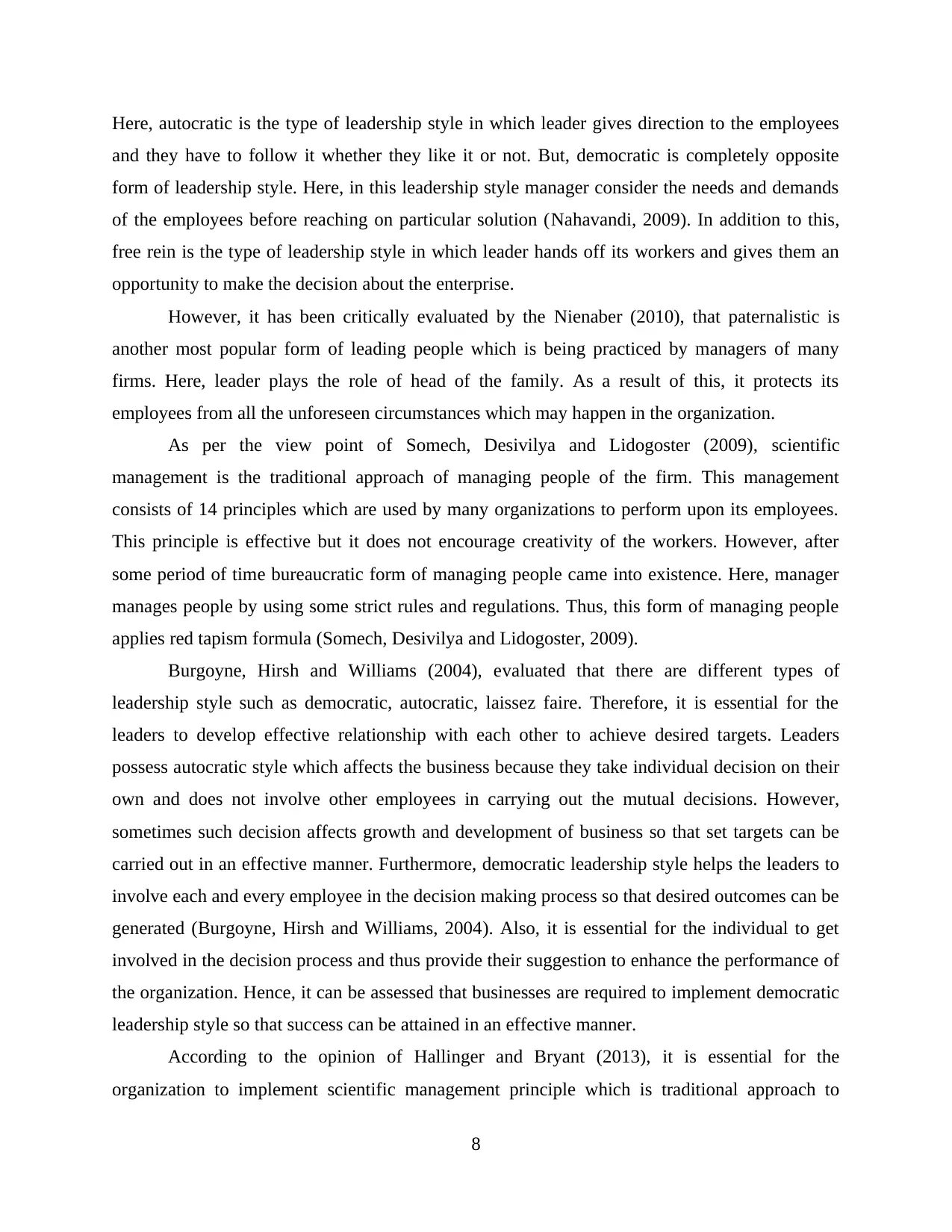
Here, autocratic is the type of leadership style in which leader gives direction to the employees
and they have to follow it whether they like it or not. But, democratic is completely opposite
form of leadership style. Here, in this leadership style manager consider the needs and demands
of the employees before reaching on particular solution (Nahavandi, 2009). In addition to this,
free rein is the type of leadership style in which leader hands off its workers and gives them an
opportunity to make the decision about the enterprise.
However, it has been critically evaluated by the Nienaber (2010), that paternalistic is
another most popular form of leading people which is being practiced by managers of many
firms. Here, leader plays the role of head of the family. As a result of this, it protects its
employees from all the unforeseen circumstances which may happen in the organization.
As per the view point of Somech, Desivilya and Lidogoster (2009), scientific
management is the traditional approach of managing people of the firm. This management
consists of 14 principles which are used by many organizations to perform upon its employees.
This principle is effective but it does not encourage creativity of the workers. However, after
some period of time bureaucratic form of managing people came into existence. Here, manager
manages people by using some strict rules and regulations. Thus, this form of managing people
applies red tapism formula (Somech, Desivilya and Lidogoster, 2009).
Burgoyne, Hirsh and Williams (2004), evaluated that there are different types of
leadership style such as democratic, autocratic, laissez faire. Therefore, it is essential for the
leaders to develop effective relationship with each other to achieve desired targets. Leaders
possess autocratic style which affects the business because they take individual decision on their
own and does not involve other employees in carrying out the mutual decisions. However,
sometimes such decision affects growth and development of business so that set targets can be
carried out in an effective manner. Furthermore, democratic leadership style helps the leaders to
involve each and every employee in the decision making process so that desired outcomes can be
generated (Burgoyne, Hirsh and Williams, 2004). Also, it is essential for the individual to get
involved in the decision process and thus provide their suggestion to enhance the performance of
the organization. Hence, it can be assessed that businesses are required to implement democratic
leadership style so that success can be attained in an effective manner.
According to the opinion of Hallinger and Bryant (2013), it is essential for the
organization to implement scientific management principle which is traditional approach to
8
and they have to follow it whether they like it or not. But, democratic is completely opposite
form of leadership style. Here, in this leadership style manager consider the needs and demands
of the employees before reaching on particular solution (Nahavandi, 2009). In addition to this,
free rein is the type of leadership style in which leader hands off its workers and gives them an
opportunity to make the decision about the enterprise.
However, it has been critically evaluated by the Nienaber (2010), that paternalistic is
another most popular form of leading people which is being practiced by managers of many
firms. Here, leader plays the role of head of the family. As a result of this, it protects its
employees from all the unforeseen circumstances which may happen in the organization.
As per the view point of Somech, Desivilya and Lidogoster (2009), scientific
management is the traditional approach of managing people of the firm. This management
consists of 14 principles which are used by many organizations to perform upon its employees.
This principle is effective but it does not encourage creativity of the workers. However, after
some period of time bureaucratic form of managing people came into existence. Here, manager
manages people by using some strict rules and regulations. Thus, this form of managing people
applies red tapism formula (Somech, Desivilya and Lidogoster, 2009).
Burgoyne, Hirsh and Williams (2004), evaluated that there are different types of
leadership style such as democratic, autocratic, laissez faire. Therefore, it is essential for the
leaders to develop effective relationship with each other to achieve desired targets. Leaders
possess autocratic style which affects the business because they take individual decision on their
own and does not involve other employees in carrying out the mutual decisions. However,
sometimes such decision affects growth and development of business so that set targets can be
carried out in an effective manner. Furthermore, democratic leadership style helps the leaders to
involve each and every employee in the decision making process so that desired outcomes can be
generated (Burgoyne, Hirsh and Williams, 2004). Also, it is essential for the individual to get
involved in the decision process and thus provide their suggestion to enhance the performance of
the organization. Hence, it can be assessed that businesses are required to implement democratic
leadership style so that success can be attained in an effective manner.
According to the opinion of Hallinger and Bryant (2013), it is essential for the
organization to implement scientific management principle which is traditional approach to
8
Paraphrase This Document
Need a fresh take? Get an instant paraphrase of this document with our AI Paraphraser
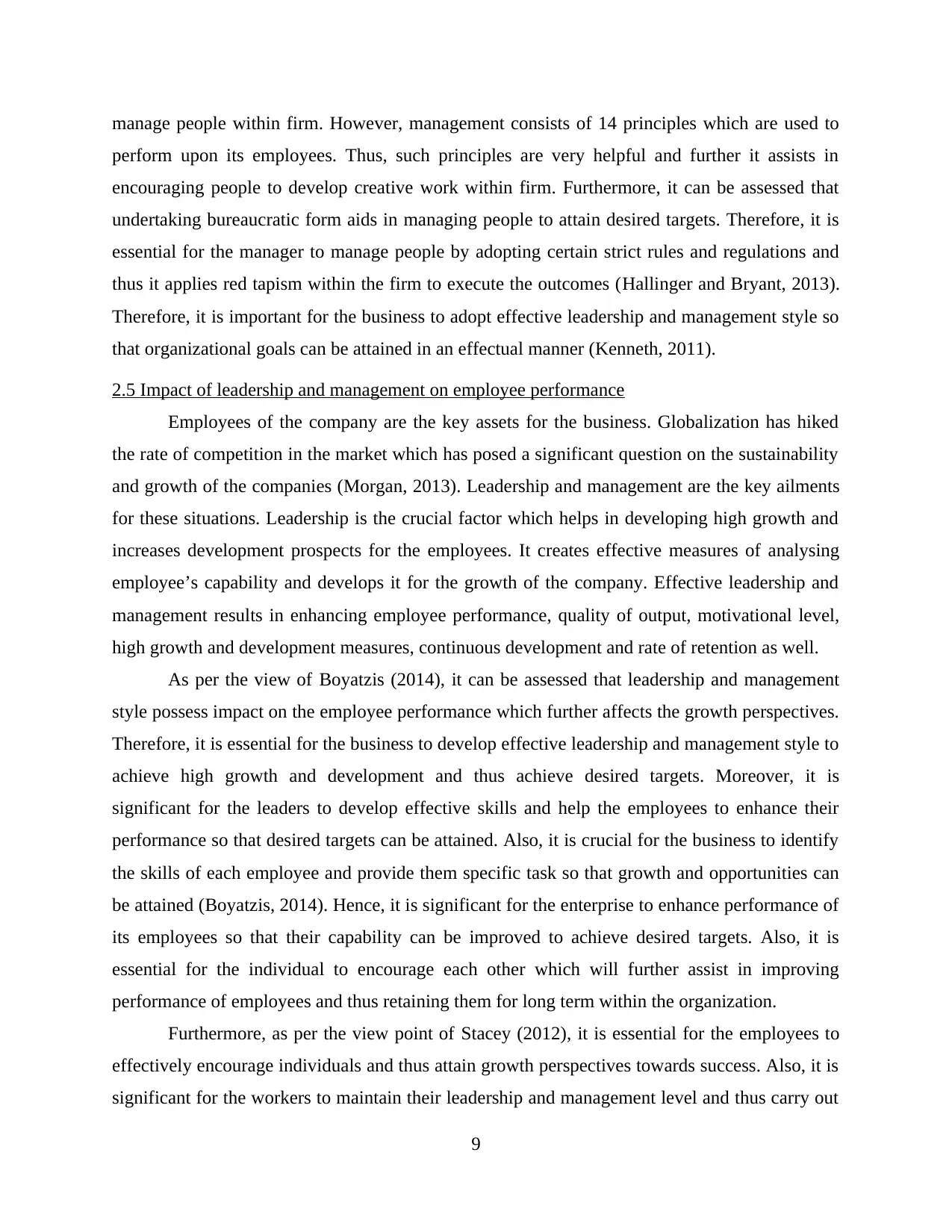
manage people within firm. However, management consists of 14 principles which are used to
perform upon its employees. Thus, such principles are very helpful and further it assists in
encouraging people to develop creative work within firm. Furthermore, it can be assessed that
undertaking bureaucratic form aids in managing people to attain desired targets. Therefore, it is
essential for the manager to manage people by adopting certain strict rules and regulations and
thus it applies red tapism within the firm to execute the outcomes (Hallinger and Bryant, 2013).
Therefore, it is important for the business to adopt effective leadership and management style so
that organizational goals can be attained in an effectual manner (Kenneth, 2011).
2.5 Impact of leadership and management on employee performance
Employees of the company are the key assets for the business. Globalization has hiked
the rate of competition in the market which has posed a significant question on the sustainability
and growth of the companies (Morgan, 2013). Leadership and management are the key ailments
for these situations. Leadership is the crucial factor which helps in developing high growth and
increases development prospects for the employees. It creates effective measures of analysing
employee’s capability and develops it for the growth of the company. Effective leadership and
management results in enhancing employee performance, quality of output, motivational level,
high growth and development measures, continuous development and rate of retention as well.
As per the view of Boyatzis (2014), it can be assessed that leadership and management
style possess impact on the employee performance which further affects the growth perspectives.
Therefore, it is essential for the business to develop effective leadership and management style to
achieve high growth and development and thus achieve desired targets. Moreover, it is
significant for the leaders to develop effective skills and help the employees to enhance their
performance so that desired targets can be attained. Also, it is crucial for the business to identify
the skills of each employee and provide them specific task so that growth and opportunities can
be attained (Boyatzis, 2014). Hence, it is significant for the enterprise to enhance performance of
its employees so that their capability can be improved to achieve desired targets. Also, it is
essential for the individual to encourage each other which will further assist in improving
performance of employees and thus retaining them for long term within the organization.
Furthermore, as per the view point of Stacey (2012), it is essential for the employees to
effectively encourage individuals and thus attain growth perspectives towards success. Also, it is
significant for the workers to maintain their leadership and management level and thus carry out
9
perform upon its employees. Thus, such principles are very helpful and further it assists in
encouraging people to develop creative work within firm. Furthermore, it can be assessed that
undertaking bureaucratic form aids in managing people to attain desired targets. Therefore, it is
essential for the manager to manage people by adopting certain strict rules and regulations and
thus it applies red tapism within the firm to execute the outcomes (Hallinger and Bryant, 2013).
Therefore, it is important for the business to adopt effective leadership and management style so
that organizational goals can be attained in an effectual manner (Kenneth, 2011).
2.5 Impact of leadership and management on employee performance
Employees of the company are the key assets for the business. Globalization has hiked
the rate of competition in the market which has posed a significant question on the sustainability
and growth of the companies (Morgan, 2013). Leadership and management are the key ailments
for these situations. Leadership is the crucial factor which helps in developing high growth and
increases development prospects for the employees. It creates effective measures of analysing
employee’s capability and develops it for the growth of the company. Effective leadership and
management results in enhancing employee performance, quality of output, motivational level,
high growth and development measures, continuous development and rate of retention as well.
As per the view of Boyatzis (2014), it can be assessed that leadership and management
style possess impact on the employee performance which further affects the growth perspectives.
Therefore, it is essential for the business to develop effective leadership and management style to
achieve high growth and development and thus achieve desired targets. Moreover, it is
significant for the leaders to develop effective skills and help the employees to enhance their
performance so that desired targets can be attained. Also, it is crucial for the business to identify
the skills of each employee and provide them specific task so that growth and opportunities can
be attained (Boyatzis, 2014). Hence, it is significant for the enterprise to enhance performance of
its employees so that their capability can be improved to achieve desired targets. Also, it is
essential for the individual to encourage each other which will further assist in improving
performance of employees and thus retaining them for long term within the organization.
Furthermore, as per the view point of Stacey (2012), it is essential for the employees to
effectively encourage individuals and thus attain growth perspectives towards success. Also, it is
significant for the workers to maintain their leadership and management level and thus carry out
9
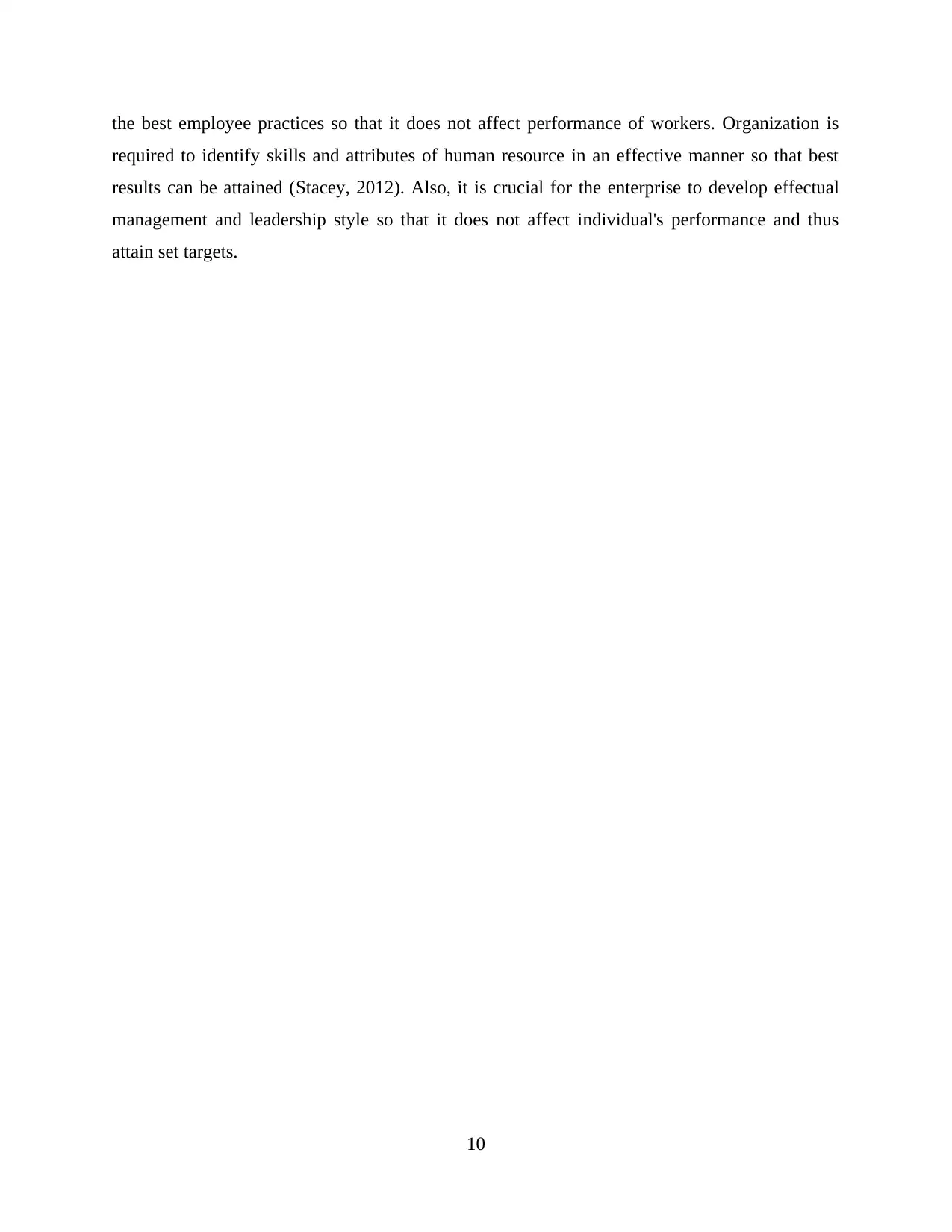
the best employee practices so that it does not affect performance of workers. Organization is
required to identify skills and attributes of human resource in an effective manner so that best
results can be attained (Stacey, 2012). Also, it is crucial for the enterprise to develop effectual
management and leadership style so that it does not affect individual's performance and thus
attain set targets.
10
required to identify skills and attributes of human resource in an effective manner so that best
results can be attained (Stacey, 2012). Also, it is crucial for the enterprise to develop effectual
management and leadership style so that it does not affect individual's performance and thus
attain set targets.
10
⊘ This is a preview!⊘
Do you want full access?
Subscribe today to unlock all pages.

Trusted by 1+ million students worldwide
1 out of 39
Related Documents
Your All-in-One AI-Powered Toolkit for Academic Success.
+13062052269
info@desklib.com
Available 24*7 on WhatsApp / Email
![[object Object]](/_next/static/media/star-bottom.7253800d.svg)
Unlock your academic potential
Copyright © 2020–2025 A2Z Services. All Rights Reserved. Developed and managed by ZUCOL.





